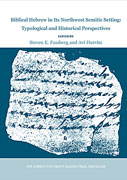
Biblical Hebrew in Its Northwest Semitic Setting
Typological and Historical Perspectives
Edited by Steven E. Fassberg and Avi M. Hurvitz
Biblical Hebrew in Its Northwest Semitic Setting
Typological and Historical Perspectives
Edited by Steven E. Fassberg and Avi M. Hurvitz
In 1961 William L. Moran published “The Hebrew Language in Its Northwest Semitic Background” (The Bible and the Ancient Near East: Essays in Honor of William Foxwell Albright, ed. G. Ernest Wright). In it, Moran presented a state-of-the-art description of the linguistic milieu out of which Biblical Hebrew developed. He stressed the features found in earlier Northwest Semitic languages that are similar to Hebrew, and he demonstrated how the study of those languages sheds light on Biblical Hebrew. More than forty years have passed since the publication of William L. Moran’s now classic description of Hebrew in the light of its Northwest Semitic background. Since the late 1950’s, when the article was written, our knowledge of both Northwest Semitic and the Hebrew of the biblical period has increased considerably.
- Description
- Table of Contents
In the light of the significant advances in the study of Biblical Hebrew and Northwest Semitic in the past four decades, an international research group on the subject of Biblical Hebrew in its Northwest Semitic setting was convened at the Institute for Advanced Studies of the Hebrew University of Jerusalem during the 2001–2002 academic year. The present volume presents the fruits of this year-long collaboration.
Preface
Moshe Bar-Asher The Qal Passive Participle of Geminate Verbs in Biblical Hebrew
Joshua Blau Problems of Noun Inflection in Arabic: Reflections on the Diptore Declension
John A. Emerton ‘The Kingdoms of Judah and Israel and Ancient Hebrew History Writing
Steven E. Fassberg Sequences of Positive Commands in Biblical Hebrew lek ‘emor, lek we’amarta, halok we’amarta
W. Randall Garr The Paragogic run in Rhetorical Perspective
Edward L. Greenstein Forms and Functions of the Finite Verb in Ugaritic Narrative Verse
John Huehnergard On the Etymology of the Hebrew Relative: she
Avi Hurvitz Continuity and Change in Biblical Hebrew: The Linguistic History of a Formulaic Idiom from the Realm of the Royal Court
Jan Joosten The Disappearance of Iterative WEQATAL in the Biblical Hebrew Verbal System
Menahem Zevi Kaddari Homonymy and Polysemy in the New Modern Hebrew Lexicon of the Hebrew Bible
Geoffrey Khan Some Aspects of the Copula in North West Semitic
André Lemaire Hebrew and Aramaic in the First Millennium BCE in the Light of Epigraphic Evidence (Socio-Historical Aspects)
André Lemaire and Ada Yardeni New Hebrew Ostraca from the Shephelah
Mordechay Mishor On the Language and Text of Exodus 18
Adina Moshavi The Discourse Functions of Object/Adverbial-Fronting in Biblical Hebrew
Alviero Niccacci The Biblical Hebrew Verbal System in Poetry
M. O’Connor The Human Characters’ Names in the Ugaritic Poems: Onomastic Eccentricity in Bronze-Age West Semitic and the Name Daniel in Particular
Frank H. Polak Linguistic and Stylistic Aspects of Epic Formulae in Ancient Semitic Poetry and Biblical Narrative
Elisha Qimron The Pausal Patah in Biblical Hebrew
Gary A. RendsburgIsraelian Hebrew in the Song of Songs
Mailing List
Subscribe to our mailing list and be notified about new titles, journals and catalogs.



